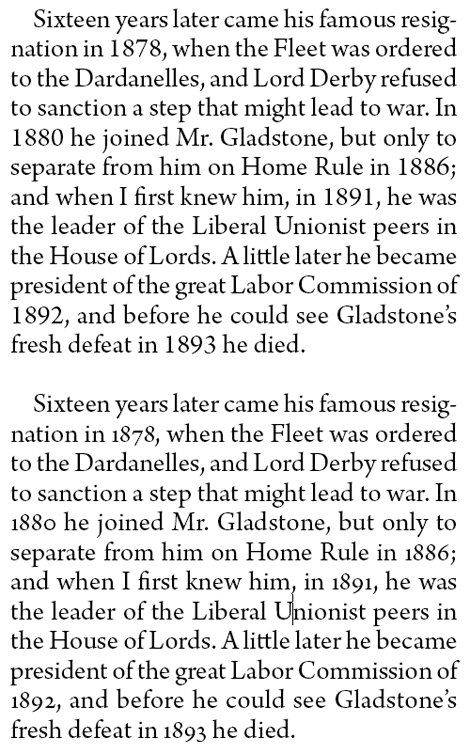Pick a Numeral
Even among those who obsess about the text we set — tweaking kerning, tracking, alignments — numbers tend to get short shrift. It’s as if there’s nothing to do with them but make sure they’re in the correct typeface. But it’s just not so — you have more options and more control than you might think.
The key to more expressive setting of numbers is having a choice over which kind of numerals — or figures — to use. Fonts with small character sets have always been a problem in this regard, because they typically only contain what are variously called lining, ranging, or uppercase numerals, what most of us know as plain vanilla numbers:

These numerals are generally as tall as the capital letters in a given face, which explains one of their names. The term lining comes from the fact that they all they sit on the baseline and rise to the same height. Ditto for ranging; same idea, different expression.
Apart from this stylistic distinction, lining numerals also typically embody the second variable that distinguishes kinds of numerals: uniform character width. Numerals that all have the same width are called tabular, because they line up when set in tables. They’re all the same height, and they’re all the same width.
When all numerals in a typeface have the same character width, they align in neat columns in situations such as financial reports. The green highlights added to the table below show that all of the numerals have the same character width, resulting in a tidily aligned layout.

The alternative to lining figures are old-style or lowercase figures. These have no consistent height and have ascending and descending features like lowercase letters:

In addition, old-style figures in a given typeface generally have unique widths, just like alphabetic characters. For this reason, they’re also called proportional figures. Because both their heights and their widths vary, old-style figures aren’t usually used in tabular work because they don’t create as tidy an appearance as lining, tabular numerals do. In complex tables, or where table type is fairly small, old-style numerals can make for difficult reading.
In the example below, the top row has the lining tabular numerals of Adobe Garamond, with its old-style proportional alternates below. At the bottom of the example is a portion of the character-width table from within the font, highlighting the diverse widths of the old-style numerals. The widths are expressed in thousandths of an em. By comparison, all of the lining tabular numerals in Adobe Garamond are 500/1000 em wide.

Forms of numerals other than the tabular lining variety are uncommon, if not downright rare. If you have older fonts with companion “expert sets,” or you use TrueType or OpenType fonts with large character sets, you may have access to some or all of these alternative numeral forms. The only way to know if they’re in your fonts is to take a peek inside using Windows Character Map (found in the Start menu, under All Programs) or Mac OS’s Character Palette. (To use Character Palette, you first have to activate the Finder’s Input menu and add the Character Palette to it. Do this by opening System Preferences from the Applications menu and clicking on International. Then select the Input Menu tab. In the ensuing dialog box, click to put a check mark next to Character Palette at the top of the scrolling list and one next to “Show input menu in menu bar” at the bottom of the window. Close the window, and the Input menu — indicated by a flag icon — appears at the right-hand side of the menu bar. Whew.). Adobe InDesign and QuarkXPress also offer a Glyphs palette that lets you browse the contents of your fonts.
Relatively few typeface families offer both lining and old-style numerals, although the latter are becoming an increasingly common feature in TrueType and OpenType fonts that have larger character set.
Rarer still are proportional lining figures and tabular old-style figures. They show up in a handful of OpenType “pro” fonts, and if you really want to use these figures, your choice of typefaces will be quite small.
Text and Display
Tabular lining numerals work best in tables. In body text — in books, for example — they tend to look horsy, just as material set in all capitals does. Just as small caps are an alternative to passages of full-size caps, in setting numerals, the alternative to lining figures are old-style numerals.
In the first of the example paragraphs below, the dates set in lining numerals jump out of the text — they’re the first thing your eye falls on when you glance at the text block. In the second sample, the numerals have been set in old-style figures, which blend in much better with the scale and texture of what’s around them.

The opposite tends to be true in display type, where lining numerals often seem better proportioned in larger and more muscular type. There’s no rule about using one or the other, but once you settle on a style for a project, stick with it and don’t switch back and forth.
In the two newspaper headlines below, the lining figures used in the top version are better proportioned for the setting. The old-style numbers in the bottom version look too puny.

Kerning Numerals
The uniform widths of tabular numerals work more or less well for most of the digits, but the 1 is a notable exception. When set amid other numerals, it always looks like it needs kerning. In everyday body type, this usually isn’t worth fussing with.
Some typefaces include a kerning or non-tabular 1. It has a narrower character width than a normal 1 and produces better spacing. It too is a rare bird, but easier to work with than manual kerning. If your font contains this character, use find-and-replace to substitute kerning 1s for non-kerning 1s.
In the absence of these, the obsessive QuarkXPress user can add custom kerning values using the program’s Kerning Table Editor, but it’s a lot of work. (InDesign doesn’t allow you to alter kerning tables). You’ll have to add kerning adjustments for pairs that include every numeral and punctuation mark that might reasonably precede or follow the 1. These include currency symbols, period, comma, and parentheses. Then you have to remember to disable automatic kerning whenever you want to use your tabular figures in tables, or you won’t have tabular figures any more.
In display type, though, it’s always worth kerning the tabular numeral 1, as well as any other numerals, for that matter. Below is an example of the benefit of doing this, where the 1 in the date has been kerned both against the hyphen that precedes it and the 9 that follows it:

When using old-style numerals, kerning isn’t an issue except in display type, where some hand tweaking will be required, just as it is with alphabetic characters.
When in Rome
No discussion of numerals would be complete with mentioning Roman numerals, even if there isn’t much to say about them, except to mention a couple of copy-editing conventions. When using Roman numerals for page numbers, as in the front matter of books, it’s normal to use lowercase characters: i, iv, x, and so forth. Roman numerals in capitals are usually reserved for royalty: Louis XIV.



That was the a super article this morning – Great examples and explanations, and I enjoyed the dig at executive bonuses ;-)
I’ve known about the different numeral styles before, but it never really occurred to me that this makes them upper-case and lower-case . . . numbers. But it makes sense.
You forgot to mention small cap figures. I have them in all of my fonts, and some of the Dutch do also.
“Small cap” figures are exactly the same as old-style figures; old-style figures are commonly included with small caps.
That was the a super article this morning – Great examples and explanations, and I enjoyed the dig at executive bonuses
sesli sohbet sesli chat